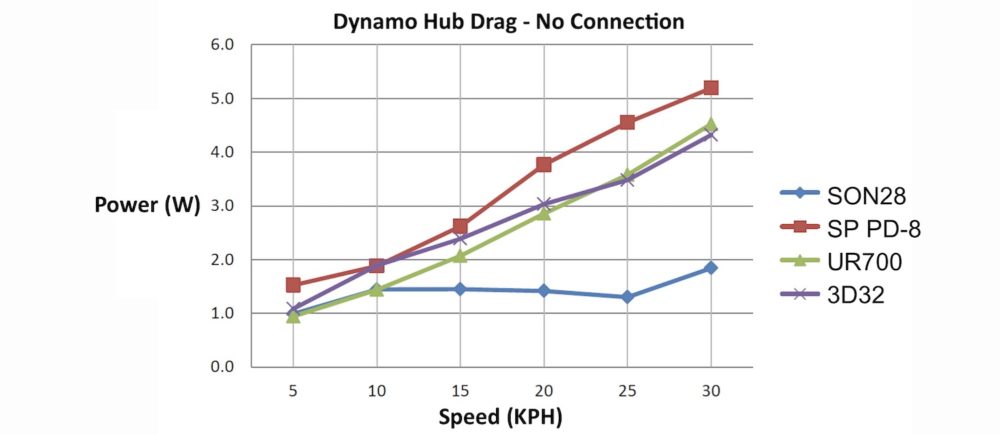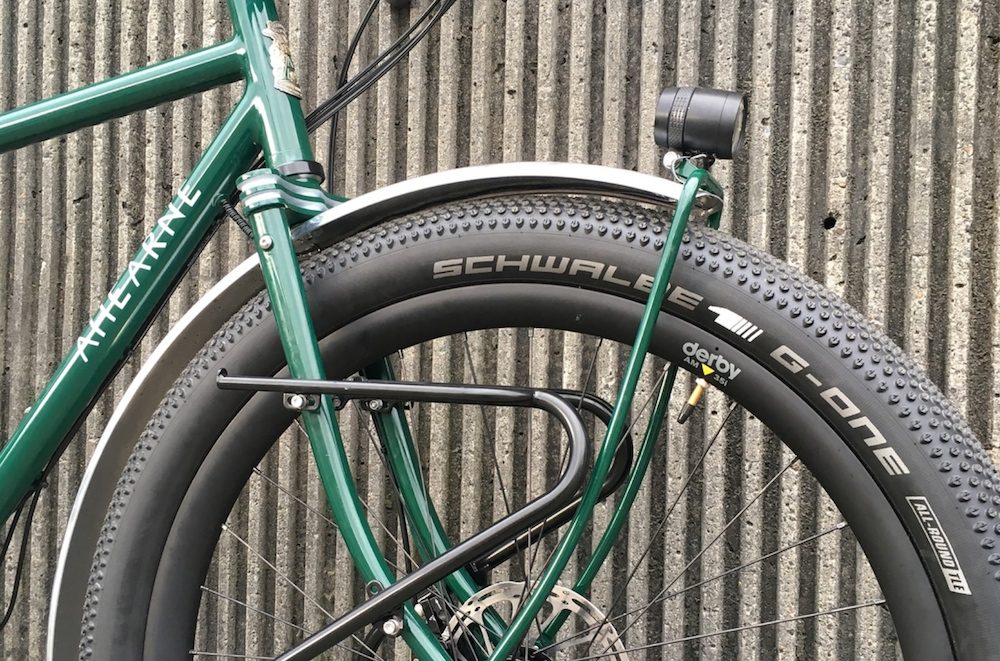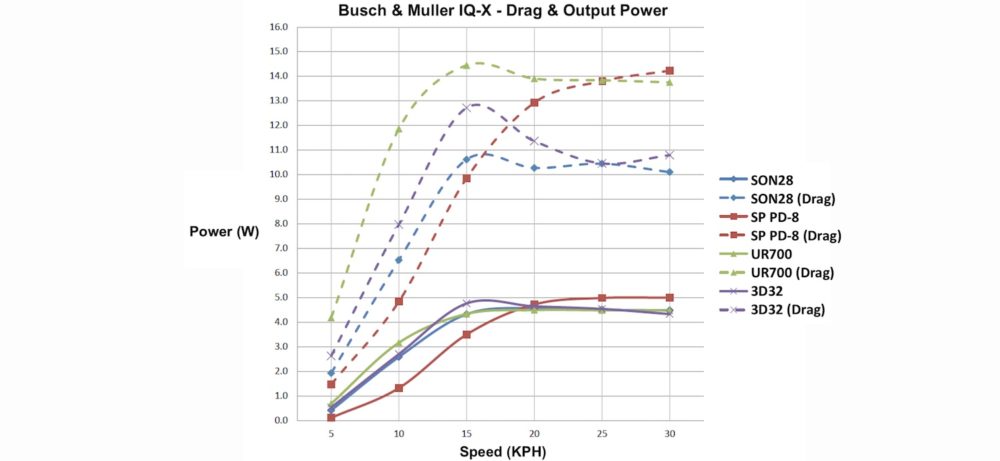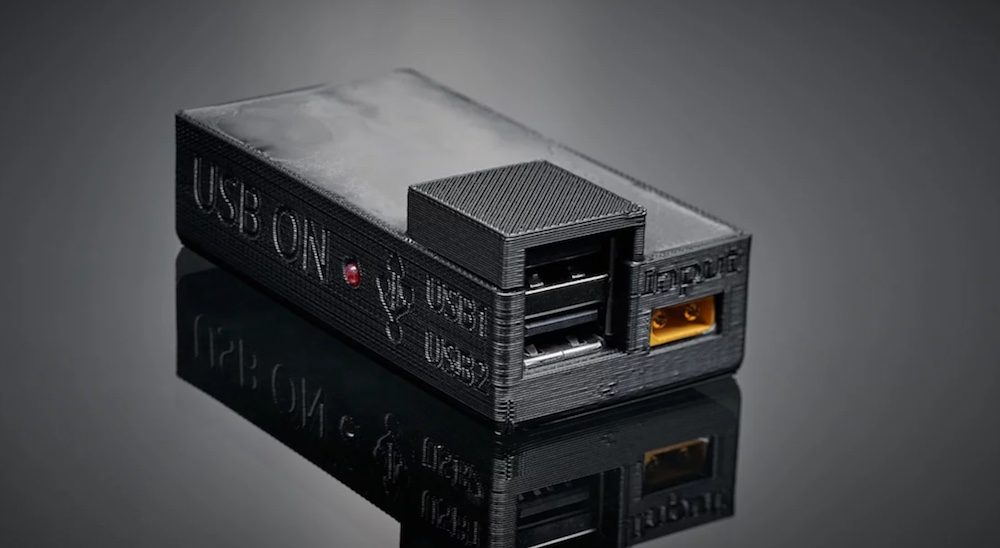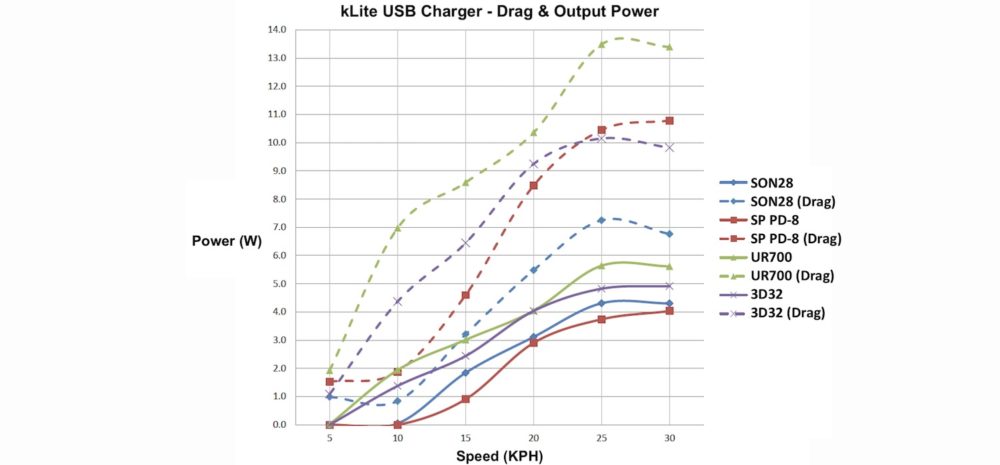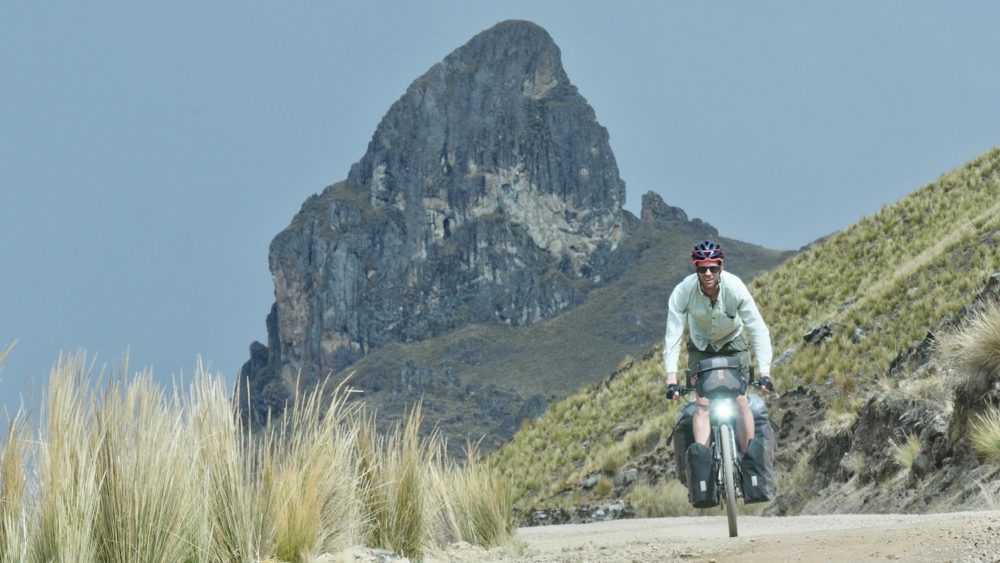Table of Contents
I have used and recommended dynamo setups for over a decade as I love not having to think about charging battery lights or sourcing power for my devices.
You will often hear remarks like ‘my dynamo hub doesn’t slow me down at all’. While it may not feel that way, there is always a cost when it comes to bicycle power production, and today, I’ll tell you how much dynamo drag will likely slow you down.
Finding the exact number is surprisingly tricky. It depends on dozens of factors including (but not limited to) rider weight, fitness level, bike weight, wheel size, tyre width, road surfaces, cycling speed – and the specific hub, charger and lights that are fitted to your bike.
To get a sense of the drag, I will be creating two different rider scenarios and running them on both flat and 5% road gradients. We will then calculate the speed differences of both the highest and lowest-drag hubs when paired with different USB chargers and dynamo lights.
Let’s start with a quick overview of the dynamo components.
The Components That Make A Dynamo Setup

Hub Dynamo
Hub dynamos generate power by passing magnets over a copper coil, and it is here where the physical drag occurs. Hubs actually vary a surprising amount in terms of both power output and efficiency, you’ll be able to see the lowest-drag hubs on some graphs below.
USB Chargers
USB chargers convert the power from your hub into a useable form at the USB plug. Depending on how the electronics have been designed, there are power output and efficiency differences here too. But importantly, the resistance at the wheel is based on how much power your plugged-in device is drawing from the hub, and this can vary quite a bit. For example, a Garmin GPS at 25KPH would likely have 6 or 7x less resistance than a big smartphone.
Dynamo Lights
When it comes to lighting, brighter lights will typically slow you down more than dimmer lights. Most dynamo lights achieve their maximum brightness (and therefore drag) between 15 and 20KPH. Personally, I think lighting is the number one reason someone should use a dynamo setup – they’re just so convenient.
My Two Cyclists
For today’s estimations, we will look at two different rider scenarios.
The smaller rider weighs 60kg and their bike plus gear is 25kg. As the average cyclist pedals at around two watts-per-kilogram on a long ride, this rider will be pushing 120-watts for the simulation.
The bigger rider is 90kg and their bike plus gear is also 25kg. They will pedal their bike at 180-watts.
Dynamo Drag Data And Calculations
I am using dynamo power and drag data collected on Skjegg Blogspot. You can find links to the original test HERE and my interpretation of the results HERE.
I have then used Bike Calculator to determine the speed differences at different power outputs. Through my own real-world testing, I have found this tool to work with very high accuracy.
Hub Dynamo With Nothing Connected

Let’s start with the hub drag with nothing connected. This graph shows the drag of four different dynamo hubs at speeds between 5 and 30KPH. You will notice that most hubs increase in resistance the faster you go; the exception is the Schmidt SON28 which has some black magic going on to achieve a somewhat steady drag at different riding speeds.
Speed difference on the flat:
Smaller cyclist with no dynamo hub – 21.70KPH
Smaller cyclist with the lowest-drag hub – 21.61KPH – 0:14 behind per hour (0.4% slower)
Smaller cyclist with the highest-drag hub – 21.37KPH – 0:54 behind per hour (1.5% slower)
Bigger cyclist with no dynamo hub – 24.62KPH
Bigger cyclist with the lowest-drag hub – 24.56KPH – 0:07 behind per hour (0.2% slower)
Bigger cyclist with the highest-drag hub – 24.32KPH – 0:43 behind per hour (1.2% slower)
Speed difference on a 5% climb:
Smaller cyclist with no dynamo hub – 7.77KPH
Smaller cyclist with the lowest-drag hub – 7.71KPH – 0:29 behind per hour (0.8% slower)
Smaller cyclist with the highest-drag hub – 7.68KPH – 0:43 behind per hour (1.2% slower)
Bigger cyclist with no dynamo hub – 8.64KPH
Bigger cyclist with the lowest-drag hub – 8.59KPH – 0:22 behind per hour (0.6% slower)
Bigger cyclist with the highest-drag hub – 8.56KPH – 0:32 behind per hour (0.9% slower)
Note: for my comparisons, I am subtracting the expected drag of a high-quality hub from all rider scenarios – that’s 0.25-watts at low speeds, 0.5-watts at high speeds.
Hub Dynamo With A Light Connected
For this scenario, we’ll be looking at how much a very bright 100lux dynamo light will slow you down. I have selected the data from the B&M IQ-X, which is one of the brightest options available and one that I personally recommend.
Speed difference on the flat:
Smaller cyclist with no dynamo hub – 21.70KPH
Smaller cyclist with the lowest-drag hub – 20.75KPH – 2:38 behind per hour (4.4% slower)
Smaller cyclist with the highest-drag hub – 20.39KPH – 3:36 behind per hour (6.0% slower)
Bigger cyclist with no dynamo hub – 24.62KPH
Bigger cyclist with the lowest-drag hub – 23.89KPH – 1:48 behind per hour (3.0% slower)
Bigger cyclist with the highest-drag hub – 23.64KPH – 2:24 behind per hour (4.0% slower)
Speed difference on a 5% climb:
Smaller cyclist with no dynamo hub – 7.77KPH
Smaller cyclist with the lowest-drag hub – 7.53KPH – 1:52 behind per hour (3.1% slower)
Smaller cyclist with the highest-drag hub – 7.28KPH – 3:47 behind per hour (6.3% slower)
Bigger cyclist with no dynamo hub – 8.64KPH
Bigger cyclist with the lowest-drag hub – 8.40KPH – 1:41 behind per hour (2.8% slower)
Bigger cyclist with the highest-drag hub – 8.16KPH – 3:22 behind per hour (5.6% slower)
Note: for my comparisons, I am subtracting the expected drag of a high-quality hub from all rider scenarios – that’s 0.25-watts at low speeds, 0.5-watts at high speeds.
Hub Dynamo With A USB Charger Connected
We will be using a kLite USB charger for this example, and we will be assuming that your device is consuming all power available at the USB port. Keep in mind that hub dynamos also vary in power output at the same speed – more power results in more drag. As the Shimano UR700 provides 25% more power at the USB plug than the SON hub, this is not a perfectly fair comparison.
On the 5% climb, I cannot simulate the SON28 as it’s not yet making good power with the kLite charger, so we will compare the two Shimano hubs instead.
Speed difference on the flat (UR700 vs SON28):
Smaller cyclist with no dynamo hub – 21.70KPH
Smaller cyclist with the lowest-drag hub – 21.15KPH – 1:30 behind per hour (2.5% slower)
Smaller cyclist with the highest-drag hub – 20.66KPH – 2:53 behind per hour (4.8% slower)
Bigger cyclist with no dynamo hub – 24.62KPH
Bigger cyclist with the lowest-drag hub – 24.13KPH – 1:12 behind per hour (2.0% slower)
Bigger cyclist with the highest-drag hub – 23.66KPH – 2:20 behind per hour (3.9% slower)
Speed difference on a 5% climb (UR700 vs 3D32):
Smaller cyclist with no dynamo hub – 7.77KPH
Smaller cyclist with the Shimano 3D30 hub – 7.76KPH – 0:04 behind per hour (0.1% slower)
Smaller cyclist with the Shimano UR700 hub – 7.46KPH – 2:24 behind per hour (4.0% slower)
Bigger cyclist with no dynamo hub – 8.64KPH
Bigger cyclist with the Shimano 3D30 hub – 8.61KPH – 0:11 behind per hour (0.3% slower)
Bigger cyclist with the Shimano UR700 hub – 8.38KPH – 1:48 behind per hour (3.0% slower)
Note: for my comparisons, I am subtracting the expected drag of a high-quality hub from all rider scenarios – that’s 0.25-watts at low speeds, 0.5-watts at high speeds.
Bonus: Predicting Time Loss With A More Powerful USB Charger

I personally use a Cinq Plug5 Plus USB charger and Schmidt SON28 hub dynamo on my bike, so I’m running these predictions more for my own curiosity than anything else.
Using the Schmidt hub charging efficiencies from the kLite graph above and the power output figures of the Plug5 Plus from some other independent testing, I can crunch the numbers to try to predict what my more powerful USB charger will likely cost our two simulated riders.
Speed difference on the flat:
Smaller cyclist with no dynamo hub – 21.70KPH
Smaller cyclist with the Schmidt SON28 hub – 20.89KPH – 2:13 behind per hour (3.7% slower)
Bigger cyclist with no dynamo hub – 24.62KPH
Bigger cyclist with the Schmidt SON28 hub – 23.98KPH – 1:34 behind per hour (2.6% slower)
Speed difference on a 5% climb:
Smaller cyclist with no dynamo hub – 7.77KPH
Smaller cyclist with the Schmidt SON28 hub – 7.57KPH – 1:34 behind per hour (2.6% slower)
Bigger cyclist with no dynamo hub – 8.64KPH
Bigger cyclist with the Schmidt SON28 hub – 8.48KPH – 1:08 behind per hour (1.9% slower)
Drag/efficiency figures for these calculations:
kLite efficiency @ 24.6KPH = 59.7% —–> Cinq Plug5 Plus @ 24.62KPH = 5.2-watts —–> Drag is 8.7-watts
kLite efficiency @ 21.7KPH = 57.4% —–> Cinq Plug5 Plus @ 21.70KPH = 4.8-watts —–> Drag is 8.4-watts
kLite efficiency @ 8.64KPH = 28.6% —–> Cinq Plug5 Plus @ 8.64KPH = 0.95-watts —–> Drag is 3.3-watts
kLite efficiency @ 7.77KPH = 28.6% —–> Cinq Plug5 Plus @ 7.77KPH = 0.95-watts —–> Drag is 3.3-watts
How Much Does Dynamo Drag Slow You Down?
The most-efficient hub will slow you down:
10-30 seconds per hour with no lights or chargers attached
1-2 minutes per hour with a USB charger
1.5-2.5 minutes per hour with a bright light
The least-efficient hub will slow you down:
0.5-1 minute per hour with no lights or chargers attached
2.5-3 minutes per hour with a USB charger
2.5-4 minutes per hour with a bright light
Hub dynamos run well with nothing connected. On the flat, my Schmidt hub is probably slowing me down only 7-seconds per hour.
When charging a smartphone, I am likely losing around 1.5 minutes per hour, which I think is very reasonable given how convenient it is to always have power on tap. A low-power device like a Garmin GPS would likely cost me around 20 seconds per hour in comparison.
That said, dynamo lights are my number one reason for using a dynamo setup, and I’m happy to lose a couple of minutes per hour at night for sheer convenience. But if I was ultra racing at the pointy end of the field, this data would make me consider whether I can get by with battery-powered lights, as I could potentially save 25-40 minutes in an overnight push – which is a decent nap!
When an ultra course allows for it, less bright dynamo lights could be a better option. The B&M Cyo, which is half the brightness of the light we simulated (B&M IQ-X), would probably cost around a minute per hour when paired with the Schmidt SON28 hub.
You Can See All Of My Dynamo Resources Listed HERE


